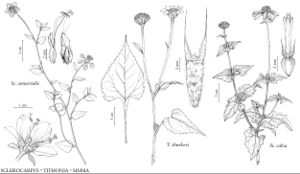Simsia
Syn. Pl. 2: 478. 1807.
| Taxon | Illustrator ⠉ | |
|---|---|---|
 | Sclerocarpus uniserialis Tithonia thurberi Simsia calva | Linny Heagy Yevonn Wilson-Ramsey Yevonn Wilson-Ramsey |
Annuals, perennials, or subshrubs [shrubs], 20–400 cm. Stems erect or ascending [decumbent], sparingly to freely branched. Leaves cauline; opposite (proximal) or alternate [whorled]; petiolate (petioles often ± winged, often with expanded bases, those bases sometimes fused to form nodal “discs”) [sessile]; blades 3-nerved from bases, mostly deltate to ovate [linear], sometimes 3- [5-] lobed [pinnatifid], bases cordate to cuneate, ultimate margins entire or toothed, faces hirsute, hispid, pilose, puberulent, scabrous, or scabro-hispid [sericeous], often glanddotted or ± stipitate-glandular to glandular-puberulent. Heads radiate [discoid], borne singly or in 2s or 3s, or in tight to loose, corymbiform [paniculiform] arrays. Involucres campanulate [ovoid-campanulate to urceolate], 5–16 [–22] mm diam. Phyllaries persistent, [11–] 13–43 [–66] in 2–4 series (tightly appressed to broadly reflexed, unequal to subequal). Receptacles low-convex, paleate (paleae conduplicate, ± enclosing cypselae). Ray-florets [0–] 5–21 [–45], styliferous and sterile; corollas orange-yellow [lemon-yellow, pink, purple, or white]. Disc-florets [12–] 13–154 [–172], bisexual, fertile; corollas concolorous with rays (usually turning purple apically), tubes (often glandular-hairy) shorter than throats, lobes 5, ± triangular (anthers black, yellow, or yellow proximally and bronze or purple distally; style-branches relatively slender, apices sometimes attenuate). Cypselae flattened, thin-margined [thickened, biconvex] (shoulders minute to conspicuous, faces glabrous or hairy); pappi 0, or fragile or readily falling, of 2 ± subulate scales [plus 4–12 shorter scales]. x = 17.
Distribution
sw United States, Mexico, West Indies (Jamaica), Central America, South America
Discussion
Species 20 (2 in the flora).
Selected References
Lower Taxa
Key
| 1 | Perennials or subshrubs (roots fusiform-thickened); ray florets 8–21, corollas light orange-yellow (abaxial faces often brown- or purple-lined, or wholly brown or purple); disc florets (26–)90–154; anthers usually yellow, rarely black | Simsia calva |
| 1 | Annuals (rarely persisting, taprooted or fibrous rooted); ray florets 5–10, corollas orange-yellow; disc florets 13–27; anthers yellow proximally, usually purple to bronze distally | Simsia lagasceiformis |